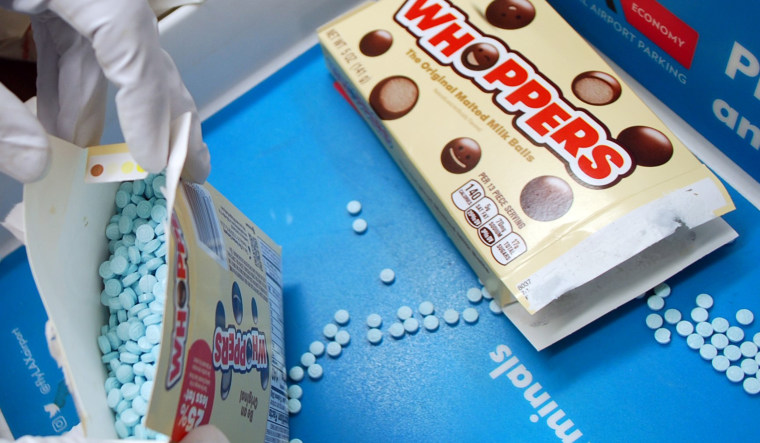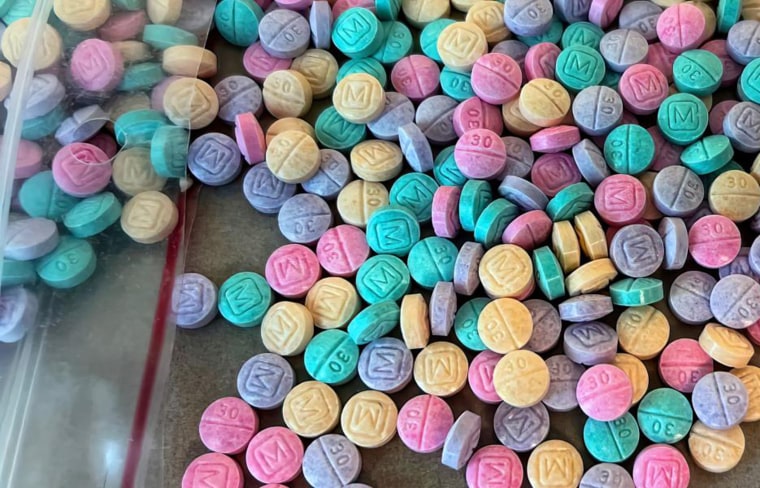Multiple news reports over the past few weeks have claimed that fentanyl may be lurking in the Halloween candy that kids will pick up trick-or-treating this year. And while fentanyl — a synthetic opioid 50 to 100 times stronger than morphine — is dangerous, it’s a myth that you might find it in Halloween candy, experts and officials say.
Some of the most recent reports were based on a drug bust in Los Angeles earlier this month: On Oct. 19, the Los Angeles Sheriff's Department seized 12,000 presumed fentanyl pills at the airport, according to a release from the department. The suspect was trying to get through security and board a plane with the pills, stored in Skittles, Whoppers and Sweetarts boxes and bags.

In the release, the department urged parents to check their kids' candy before they eat it this Halloween and to alert law enforcement if they find anything resembling narcotics in candy packaging.
The idea that the pills, which look like pharmaceuticals, could end up in trick-or-treat bags because they were being smuggled in candy bags and boxes is "illogical," Dr. Ryan Marino, a medical toxicologist and addiction medicine doctor at Case Western Reserve University School of Medicine in Cleveland, told TODAY.
"These drugs ... were hidden inside of something to try to avoid detection," he said. "The use of candy packaging does not signify that these are being passed off as candy, and certainly does not imply that the drugs someone is going to lengths to smuggle would then be given away for free rather than sold for profit."
"Drugs have been smuggled in religious iconography without prompting calls to avoid churches," he added.
Capt. Brandon Dean of the Los Angeles Sheriff's Department also told TODAY he doesn't believe the pills were supposed to be given to kids on Halloween simply because they were in candy packaging. "We don't think anybody is planting stuff in candy," he said.
Asked why the department urged parents to check Halloween candy if no one believes the pills were meant to end up in trick-or-treaters' hands, Dean said: "There's always that possibility ... that these pills get mixed in with other things. ... I don't think the message was we're worried about people planting stuff in kids' candy. It was still just be diligent checking your kid's stuff."
Why are people worried about rainbow fentanyl in Halloween candy?
Prior to the Los Angeles drug bust, there was already hubbub around fentanyl finding its way into Halloween candy — in particular, a substance referred to as rainbow fentanyl, which is fentanyl pills or powder colored with bright dyes.
In August, the U.S. Drug Enforcement Administration shared a press release warning that rainbow fentanyl was being seized across the nation in multiple forms. While the DEA said that their laboratory testing determined that the substance was not more potent than non-colorful fentanyl, the organization said they were concerned that the colorful versions of the drug were being used "to look like candy" and attract "children and young people."
Multiple experts in the field of substance use and harm reduction told TODAY they were skeptical of the DEA's claims, noting that colorful, illicit pills have existed for years and include substances like ecstasy, not just fentanyl. The experts said there's no data to suggest drug dealers are targeting children but also stressed that fentanyl is a public health problem. Two-thirds of the 108,000 drug overdose deaths in the U.S. in 2021 involved synthetic opioids like fentanyl, per the Centers for Disease Control and Prevention.

"Multicolored pills are a thing in (legitimate) pharmaceuticals, and these probably emerged to mimic what are actual pills and how those look," said Marino. He noted that a publicity photo shared by the DEA appears to show fentanyl disguised as oxycodone pills. "They don't look like candy at all. ... Colored drugs have been a thing for years, if not decades."
Where does the myth about drugs in Halloween candy come from?
The myth that parents have to worry about finding drugs in their kids' Halloween candy goes back much further than the furor around fentanyl. According to Joel Best, Ph.D., a professor of sociology and criminal justice at the University of Delaware who has done decades of research on what he calls Halloween sadism, that myth is as old as modern Halloween celebrations.
"I knew a folklorist ... who was born in the '30s, and she reported hearing stories about people who would keep pennies on a skillet, and then pour hot pennies into the outstretched hands of trick-or-treaters," Best explained. "The worry that somebody might be contaminating treats has been around for a while. It picked up speed in the 1960s, and by the late 1960s, it was pretty well-embedded."
Best said that despite decades of fear, he has never found data that shows kids are being targeted with contaminated or dangerous Halloween treats.
"I have data going back to 1958 ... and I cannot find a single case of a child killed or seriously injured by a contaminated treat picked up in the course of trick-or-treating," Best said. One exception is the 1974 case of Ronald Clark O'Bryan, who distributed potassium-cyanide laced candy to his children in an effort to collect life insurance money. His 8-year-old son died, and O'Bryan was found guilty and sentenced to death. Best said that he considers this case an exception, because "that's not what people are worried about when they ask whether it's safe to go trick-or-treating."
"This is the boogeyman," Best said. "We've stopped believing in ghosts and goblins. We believe in criminals."
Best said that he's not surprised that this year, the concern is about fentanyl, rainbow or otherwise, in Halloween candy: The urban legend of tainted treats seems to come after threats are reported in the news.
"If there's a crime story in September, it will be linked to Halloween fears that year," Best said, noting that similar fears arose in 1982 after several people were killed via tainted Tylenol in September that year. There was another round of concern about drugs being distributed in 2014, Best said, after Colorado legalized retail sales of recreational marijuana.
Are law enforcement authorities worried about rainbow fentanyl in Halloween candy?
While the DEA has continued to warn about rainbow fentanyl and share press releases about seizures of the substance, DEA Administrator Anne Milgram told NBC News’ Kate Snow that the administration does not believe that children are at risk this Halloween. The DEA declined to speak to TODAY for this article, instead referencing the interview.
"At this moment ... we’ve seen nothing that indicates that this is going to be related to Halloween or that drug traffickers are putting it into Halloween candy,” Milgram said in the September interview. “If we ever had that information, I would put it out right away because I want everyone to know what we know.”
How to keep kids safe on Halloween
While there's nothing wrong with being cautious on Halloween, Marino said expending too much energy on fears of tainted treats can keep people from focusing on real ways to prevent fentanyl overdose deaths, including in kids. Drug overdose deaths almost doubled in 14 to 18-year-olds between 2019 and 2020, and they went up another 20% in the first half of 2021, NBC News reported. The increase was driven primarily by fentanyl, often packaged to look like prescription drugs.
"Being scared of things that aren't real is problematic, and we've seen that with the fentanyl touch overdose phenomenon, and the disastrous outcomes that has for everyone," said Marino, referring to the concern that people can overdose on fentanyl just by touching it, which he said is not supported by research.
The biggest, real threat to kids' health on Halloween? An injury from a car, according to the American Academy of Pediatrics. So, make sure your child has reflective tape on their costume or bag, can see well through their costume, trick-or-treats in a group, sticks to well-lit roads and the sidewalk, only uses established crosswalks and never assumes they have the right of way when a car is coming.
Related: